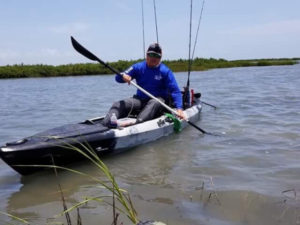How to Pick a Saltwater Kayak
By Kyle Manak
from The Fishing Wire

Choose the right saltwater kayak
When choosing a good saltwater kayak, there are many things that come to mind. First and foremost, consider what your intentions are regarding that saltwater kayak.
Where Will You Be Using Your Kayak?
Your personal fishing habits will come into play when choosing a kayak. After all, not all kayaks are made the same. Will you be fishing? Will you be in marshy waters or bays, or will you venture offshore? Marshes call for a kayak that does well in “skinny” water. Do you choose a paddling kayak or a pedal style? In waters eight inches deep or less, for instance, although your kayak will float, your pedal drive might not be usable. Knowing that you can paddle your kayak is still important. Pedal drives are great options for deeper waters of 14 inches or more, and of course, they keep your hands free when going distances or trolling. A paddle kayak can be used in all waters, but are you comfortable paddling three to six hours or more? Additionally, are you using your saltwater kayak for recreational fishing or tournament fishing? A you just searching for a good kayak you can be in all day? Make sure to ask yourself these questions while you’re shopping around.
What Size Kayak is Best for You?
This goes back to where you will be using your saltwater kayak. Most anglers like a kayak that is 12 feet or longer. This is because the longer the kayak is, the easier it is to keep on a straight path, with or without a rudder. Will you be standing for some of your fishing, or always sitting? Offshore, of course, you will be sitting, while you may decide to stand inshore sometimes. Having a kayak measuring 14 feet or longer, and with a seat in the lowest possible position, is a wise choice for offshore ventures. It allows you to breach the waves in launching or your return through the surf. YakGear’s Sting Ray and Manta Ray seats are both great options for a comfortable low, four-point seat. For occasional standing, you may want to look for a kayak measuring 36 inches wide or wider, and which has a pontoon-style keel, rather than a single sharper keel. This creates more stability, but it is not foolproof. You must always be careful. Longer and narrower kayaks are typically faster and less susceptible to cross winds. Sitting higher in a wider kayak will catch more wind, and you will have to put in a lot more effort. If you do choose to stand aboard your kayak, consider adding a YakGear StandNCast Bar to aid in balance.
Should You Sit Inside or on Top?
Many years ago, sit-inside kayaks were the only option out there. In the last 15 to 20 years, however, sit-on-top kayaks have become more popular for saltwater. A sit-inside kayak does not allow you the flexibility of standing, and if you want to get out and do a little wade fishing, it is much harder in a sit-inside than a sit-on-top.
What Should the Capacity of Your Kayak Be?
Your own size and the gear you will bring with you plays an important role in kayak selection, as well. If a kayak has a weight capacity of 300 pounds, that is the amount of weight it will hold while still allowing it to float. If you weigh 200 pounds, for example, and bring 50 pounds of gear, you are using more than 80% of the weight capacity, which will reflect in the kayak’s speed and maneuverability. Kayak Angler Magazine’s Chris Payne notes that a good rule of thumb is not to exceed 75% of your saltwater kayak’s weight capacity.
How Will You Transport Your Kayak?
Speaking of weight, make sure the size and weight of your saltwater kayak fits your transportation. Will you be hauling your kayak on top of your car? In the bed of your truck? In a trailer? All important things to keep in mind when deciding on a kayak. Also, when you get close to your launch spot, how will you get your kayak down to the water? The C-Tug cart offers two helpful options — a hard wheel for asphalt and such, and the newer Sandtrakz wheels for beach sands and other all-terrain scenarios.
I asked myself these questions and more before purchasing my kayak. A wide kayak will offer stability and comfort, but the tracking ability is diminished a bit. A longer, narrower kayak will increase your speed and tracking, but you might lose some stability. One way to pick a good saltwater kayak is to test out several options. Go to kayak demo days hosted by retailers across the United States, and test as many out as possible. Maybe borrow a friend’s kayak or rent one for the day. I promise you will know the minute you get in if it feels right. Until then, happy kayak hunting and tight lines.
About the Author:
YakGear Brand Ambassador Kyle Manak learned most of his fishing techniques — and developed a love of the water — in his hometown of Corpus Christi, Texas. Although he enjoyed boat fishing, bank fishing and wade fishing through the years, it was when Kyle ventured into kayak fishing that he found his stride and never looked back. For him, the simplicity and beauty of being on a kayak and catching a fish was something special. He was hooked by the beauty and peacefulness he experienced out on the water.
Kyle has been kayak fishing for many years now, and has extended his passion to social media. A few years ago, he created Kayak Fishing Texas, an online community which started small but today has more than 6,700 members who share the same passion. He continues to spread his passion for fishing to his own children and other children whenever he can.